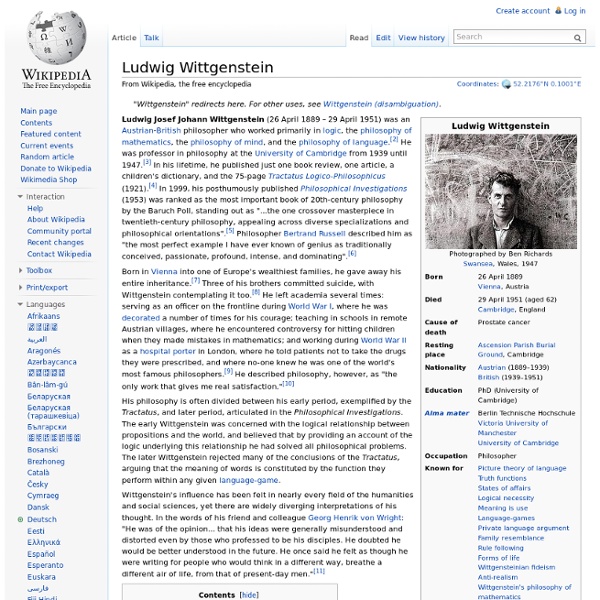Eckhart Tolle
Eckhart Tolle (/ˈɛkɑrt ˈtɒlə/ EK-art TO-lə; German pronunciation: [ˈɛkaʁt ˈtɔlə], born Ulrich Leonard Tolle on February 16, 1948) is a German-born resident of Canada,[1] best known as the author of The Power of Now and A New Earth. In 2011, he was listed by the Watkins Review as the most spiritually influential person in the world.[2] In 2008, a New York Times writer called Tolle "the most popular spiritual author in the United States".[3] Tolle has said that he was depressed for much of his life until he underwent, at age 29, an "inner transformation".
Tractatus Logico-Philosophicus
The Tractatus Logico-Philosophicus (widely abbreviated and cited as TLP) (Latin for Logical Philosophical Treatise or Treatise on Logic and Philosophy) is the only book-length philosophical work by the Austrian philosopher Ludwig Wittgenstein that was published during his lifetime. The project had a broad goal: to identify the relationship between language and reality and to define the limits of science.[1] It is recognized by philosophers as a significant philosophical work of the twentieth century. G. E.
Søren Kierkegaard
Søren Aabye Kierkegaard (/ˈsɔrən ˈkɪərkəɡɑrd/ or /ˈkɪərkəɡɔr/; Danish: [ˈsɶːɐn ˈkiɐ̯ɡəɡɒːˀ] ( )) (5 May 1813 – 11 November 1855) was a Danish philosopher, theologian, poet, social critic, and religious author who is widely considered to be the first existentialist philosopher.[5] He wrote critical texts on organized religion, Christendom, morality, ethics, psychology and philosophy of religion, displaying a fondness for metaphor, irony and parables. Much of his philosophical work deals with the issues of how one lives as a "single individual", giving priority to concrete human reality over abstract thinking, and highlighting the importance of personal choice and commitment.[6] He was a fierce critic of idealist intellectuals and philosophers of his time, such as Swedenborg,[7] Hegel, Goethe, Fichte, Schelling, Schlegel, and Hans Christian Andersen. Early years (1813–1836)[edit]
Three Models of the Universe
I once heard a recorded lecture by Alan Watts where he explained the two dominant Myths of Western culture involving the nature of the Universe. He then described a Chinese model of the Universe to contrast the other two. Here is a brief summary of each of the models… 1.) The Ceramic Model – The Universe as artifact.
Periya Puranam
The Periya Puranam (Tamil:பெரிய புராணம்), that is, the great purana or epic, sometimes called Tiruttontarpuranam ("Tiru-Thondar-Puranam", the Purana of the Holy Devotees) is a Tamil poetic account depicting the legendary lives of the sixty-three Nayanars, the canonical poets of Tamil Shaivism. It was compiled during the 12th century by Sekkizhar. It provides evidence of trade with West Asia[1] The Periya Puranam is part of the corpus of Shaiva canonical works. Sekkizhar compiled and wrote the Periya Puranam or the Great Purana, (the life stories of the sixty-three Shaiva Nayanars, poets of the God Shiva) who composed the liturgical poems of the Tirumurai, and was later himself canonised and the work became part of the sacred canon.[2] Among all the hagiographic Puranas in Tamil, Sekkizhar's Tiruttondar Puranam or Periyapuranam, composed during the rule of Kullottonga Chola II (1133-1150) stands first.[3] Background[edit] Periyapuranam[edit]
Enantiodromia
This principle was explicitly understood and discussed in the principles of traditional Chinese religion, as in Taoism and yin-yang. A central premise of the I Ching is that yang lines become yin when they have reached their extreme, and vice versa.[2] Overview[edit] The word "enantiodromia" was apparently coined by Stobaeus[3] but the concept is implied also in Heraclitus's writings. In fr. 126, for example, Heraclitus says "cold things warm, warm things cool, wet things dry and parched things get wet
Wei Wu Wei
Terence James Stannus Gray (14 September 1895 – 5 January 1986), better known by the pen name Wei Wu Wei, was a 20th-century Taoist philosopher and writer. Background[edit] Between the years 1958 and 1974 eight books and articles in various periodicals appeared under the pseudonym "Wei Wu Wei" (Wu wei, a Taoist term which translates as "action that is non-action"). The identity of the author was not revealed at the time of publication for reasons outlined in the Preface to the first book, Fingers Pointing Towards the Moon (Routledge and Kegan Paul, 1958). Eventually it was revealed that the author had been Terence Gray. Terence James Stannus Gray was born in Felixstowe, Suffolk, England on 14 September 1895, the son of Harold Stannus Gray and a member of a well-established Irish family.
Jung on the Enantiodromia: Part 1-Definitions and Examples - Jungian Center for the Spiritual Sciences
I use the term enantiodromia for the emergence of the unconscious opposite in the course of time. C.G. Jung (1949)[1] In the philosophy of Heraclitus it [enantiodromia] is used to designate the play of opposites in the course of events—the view that everything that exists turns into its opposite…. C.G.
Samarth Ramdas
Ramdas was a noted 17th century saint and spiritual poet of Maharashtra. He is most remembered for his Advaita Vedanta (Non-dualism) text Dasbodh.[1] Samarth Ramdas was a devotee of Lord Hanuman and Lord Rama. Early life and background[edit]


